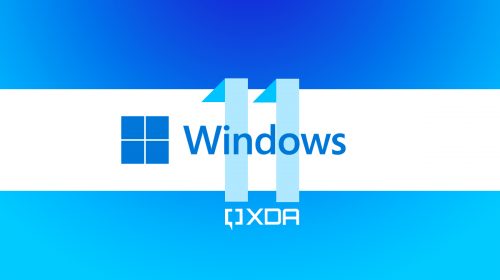Microsoft released this month’s optional cumulative update for Windows 11 users, introducing a handful of important fixes to the experience. The latest update brings the Windows 11 build number to 22000.652, which is basically the same update rolled out to Release Preview channel subscribers two weeks ago, built 22000.651.
The new update is called KB5012643and you can Download it manually here. While the changelog is mostly the same as build 220000.651, Microsoft is highlighting some special fixes this time around. In particular, there was an issue that could have prevented the minimize, maximize and close buttons from working on a maximized application window, and that has been fixed. Here is the list of highlights:
- Updates an issue that could cause video subtitles to be partially cut off.
- Updates an issue where video subtitles are incorrectly aligned.
- Displays the temperature above the weather icon on the taskbar.
- Updates an issue that prevents you from using the minimize, maximize, and close buttons in an enlarged application window.
Although not mentioned by Microsoft in the highlights, Windows 11 build 22000.652 also addresses an issue where your PC could take up to 40 minutes to boot up, which was definitely a big problem that you should have faced in the first place. If you encounter this, it will not be a problem after this update. Here is the full list of changes:
- new! Adds improvements to the Windows Secure Boot component service.
- Addresses an issue that causes the AppX Deployment Service (AppXSvc) to stop working after installing certain MSIX applications.
- Addresses a race condition that occurs early in the startup process that may cause a stop error.
- Optimizes the Autopilot client to address updated TPM capabilities that support self-deployment and pre-provisioning scenarios.
- Changes the Azure Active Directory (Azure AD) logging timeout from 60 minutes to 90 minutes for hybrid autopilot scenarios associated with Azure AD. This also handles a race condition that causes an exception when it times out.
- Addresses an issue in which some POS terminals cause occasional OS startup delays during restart of up to 40 minutes.
- Addresses a memory leak affecting Windows systems that are used 24 hours a day, 7 days a week.
- Addresses an issue that affects the Dynamic Host Configuration Protocol (DHCP) 119 (Domain Lookup option) option by preventing the use of the connection’s DNS suffix lookup list.
- Addresses an issue that affects the title attribute in Microsoft Ege IE mode.
- Addresses an issue where Mobile Device Management (MDM) policies were not allowed on Enterprise editions of Windows that were upgraded to Enterprise using subscription entitlement associated with Azure AD.
- Addresses an issue that could cause video subtitles to partially break.
- Addresses an issue where video subtitles are incorrectly aligned.
- Addresses an issue that causes Kerberos authentication to fail, the error is “0xc0030009 (RPC_NT_NULL_REF_POINTER)”. This occurs when the client machine tries to use Remote Desktop Protocol (RDP) to connect to another machine while Remote Credential Guard is enabled.
- Addresses an issue that causes Windows to switch to BitLocker recovery after a maintenance update.
- Addresses an issue that prevents the Authentication Key (EK) certificate from being retrieved from a TPM.
- Addresses an issue that may fail to copy the security portion of a Group Policy to a device.
- Addresses an issue that prevents Microsoft RDP Client Control, version 11 and later, from being instantiated within a Microsoft Foundation Class (MFC) dialog.
- Displays the temperature above the weather icon on the taskbar.
- Addresses an issue that prevents you from using the minimize, maximize, and close buttons in an enlarged application window. This issue occurs because Notification Center maintains input focus.
- Addresses an issue that may occur when using netdom.exe or the Active Directory Domains and Trusts snap-in to list or modify directive name suffixes. These actions may fail. The error message is, “Insufficient system resources to complete the requested service.” This issue occurs after you install the January 2022 security update on the Primary Domain Controller Emulator (PDCe).
- Addresses an issue that causes the root domain PDC to generate warning and error events in the system log. This problem occurs when the PDC incorrectly tries to examine only outbound trust relationships.
- Addresses an issue that occurs when mapping a network drive to a Server Message Block version 1 (SMBv1) share. After restarting the operating system, you cannot access this network drive.
- Addresses an issue that affects a multichannel SMB connection and may result in a 13A or C2 error.
- Addresses an issue that causes a pool to be destroyed when the client-side cache cleanup (CSC) method fails to delete a created resource.
- Addresses an issue that could cause the server to shut down because the nonpaged pool is growing and using all memory. After the restart, the same problem occurs again when trying to fix the corruption.
- Reduces the burden of resource contention in IOPS scenarios that have many competing threads in a single file.
If you want to get these fixes now, you can download version 22000.652 manually using the link above or simply go to the Windows Update page in the Settings app on Windows 11. Since the update is optional, it won’t install automatically, but you can check for updates and it will appear as an update Optional you can install it right away. This should be the easiest way to do it.
If you’d prefer to wait, the fixes included in this update will also be rolled out in next month’s patch Tuesday, when Microsoft rolls out a set of mandatory updates for all supported versions of Windows. These should also include additional repairs or modifications.
[ad_2]




